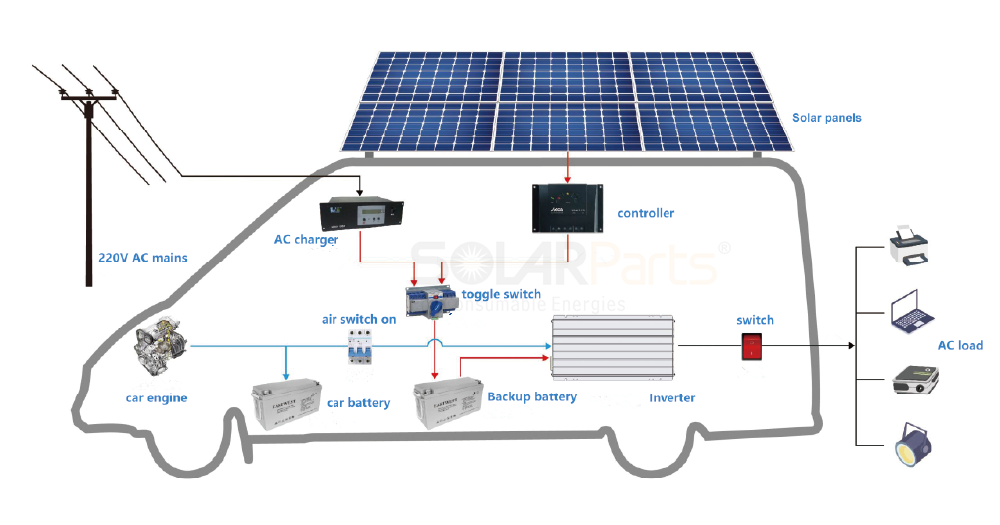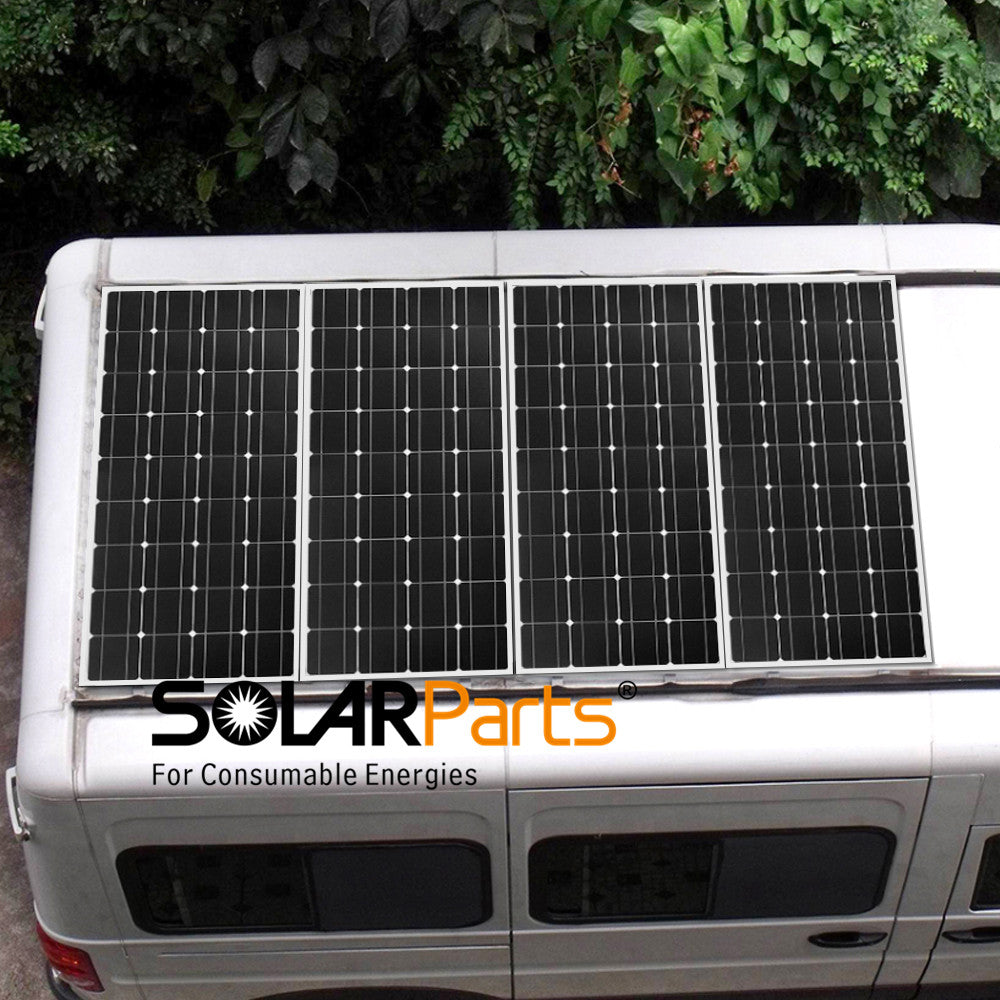Thinking of going off-the-grid in your caravan? You need enough power for your journey, and the best way to get around this is the use of solar energy.
Setting it up can be one of the most complex and daunting tasks you will need to do before you set off on your trip. Don’t worry; we’ve got you!
How much solar energy do you need?
Before you reach out to a solar energy retailer, you must first assess the amount of energy you need for your caravan. Several variables affect the amount of energy the solar panels generate:
- Time of year
- Weather
- Location
- Type of charge controller
To determine the amount you will need, let’s look at the components of a solar system for a caravan and the options available.
Your basic solar system setup for your caravan
There are four major components in a solar system that you need to know before installation:
The types of solar panels for caravans

- Glass solar panels: Glass solar panels are the most common and established solar panels for caravans today. A glass solar panel comes with a rigid frame that is attached to the roof. They are used for household and commercial installations. However, they may be vulnerable when attached to the roof. Therefore, it’s best to think about the pros and cons before you get this type of solar panel installed on your caravan’s roof.
- Flexiblesolar panels: These are lightweight and semi-flexible, making them a bit more expensive. They can be siliconed directly onto a curved roof without mounting brackets.
- Folding solar panels: This type of solar panel is gaining popularity in the caravan world today. This is because they are easy to carry around and store in a caravan – there’s no mounting required. You can pick it up and move it around the area to maximise its exposure to sunlight. Thanks to its flexibility, you can really maximise the energy absorbed from the sun.
Solarparts has a comprehensive marketplace, which may be able to assist you with purchasing the right solar panels for your caravan.
12v battery

Considered the most popular option for caravans, 12v Deep Cycle batteries deliver sufficient power to keep basic 12v appliances and other electrical items running. Additionally, it’s a whole lot cheaper in the long run. 12v batteries typically need to be replaced every five years.
Technically, you need solar panels with a 12v rating of up to 200 watts. A 200-watt panel can generate around 60 amp-hours per day in ideal weather conditions. With that, you can charge a 100ah battery in five to eight hours. Remember that your battery will require a minimum voltage to operate appliances. This means that the average deep cycle battery will need at least 50% charge to run your appliances.
So, how many solar panels do you need to charge your 12v battery? A single 200-watt panel can charge a 12v battery in a day. However, you can use smaller solar panels, but the charging time will take longer. You can also recharge your battery from mains 240v power. If you wish to run 240v rated appliances from your 12v battery, you will need an inverter.
Running 240v appliances
If you stay parked in a caravan park the entire time and are hooked up to a mains electricity supply, you won’t have a problem powering all the appliances in your caravan. However, you will likely be on the road most of the time exploring more places, thus not connected to mains power. Many appliances, such as air conditioners, require 240v – so a 12v battery WITHOUT an inverter will not be able to run these appliances.
The solution is to set up a 12v to 240v inverter that will take the 12v DC power from your caravan’s battery and convert it into 240v AC.
A basic inverter usually starts at around 100 watts but can go up to 6,000 watts. Remember that having a big inverter doesn’t necessarily mean you can run all the appliances you want. That’s not how it works!
When you’re looking for inverters on the market, you will find really cheap ones. There is nothing wrong with the cheaper versions, but they won’t be able to run anything “big.”
If you are on the road for days, weeks, or even months, you need a high-quality inverter that is a pure sine wave (a continuous wave that refers to a smooth, repetitive oscillation). Sure, you will need to pay a bit more, but it will save you a lot of money in the long run. Plus, it won’t put your electronics or appliances at risk.
How much energy will my caravan need?
A typical 12v battery will provide 100ah of power. This means that the battery should be able to provide 1 amp of power per 100 hours (or 2 amps for 50 hours, 5 amps for 20 hours, etc.).
The following table will give you a rough idea of the energy usage of common appliances in a 24-hour period:
12 Volt Battery setup with no inverter
|
Appliance |
Energy Usage |
|
LED Lights and battery monitoring devices |
Less than 0.5 amp per hour |
|
Water Pumps and Tank Level monitoring |
Less than 0.5 amp per hour |
|
Small Fridge |
1-3 amps per hour |
|
Large Fridge |
3 – 5 amps per hour |
|
Small electronic devices (small TV, laptop, music player, etc) |
Less than 0.5 amp per hour |
|
Charging mobile devices |
Less than 0.5 amp per hour |
240v setup
|
Appliance |
Energy Usage |
|
Air-conditioning and heating |
60 amps per hour |
|
Washing machine |
20 – 50 amps per hour |
|
Microwaves, Kettles, electric frypans, hair dryers |
20 – 50 amps per hour |
We highly recommend speaking with a caravan battery specialist who takes into account your energy needs and recommends a battery/solar setup.
The installation
So, how do you get a 12v or 240v solar set up on your caravan? The easiest way to install solar for your caravan is to purchase a solar panel kit. A pre-configured solar panel kit comes with all the necessary parts.
A typical solar panel kit will include at least two solar panels, a charge controller, mounting brackets to fit the panels to the caravan’s roof, cables, fuses, and connectors. You will find that most solar panel kits today don’t come with a battery or an inverter—and you will need to buy them separately.
On the other hand, you can choose to purchase every component you need for your 12v solar installation for your caravan, especially if you have specific brands in mind.
Now, are you ready for your DIY installation?
Whether you’re installing a 12v or 240v set-up, the process is pretty much the same.
1. Prepare your tools
When you’re ready to install solar to your caravan, you only need the average DIY kit that contains:
- Screwdrivers
- Drill (with two bits)
- Wire strippers
- Snips
- Caulking gun
- Electrical tape
2. Plan the cable route
The ideal location for your solar panels is your caravan’s roof; however, you still need to consider the perfect area on your roof. Think about the cable route and where your 12v or 240v battery will be kept in the caravan.
You want to minimize the cable routing inside the van as much as possible. The best location is where it will be easy for you to access a top locker and vertical cable trunking.
Remember, the best cable routes are not always easy to find, and you might need to remove some pieces of trim to clear the way. There are a lot of people who use the 12v locker because it has the cable trunking already running down towards the floor. Plus, most caravans have one to two of these to run the factory cables, and you may even get some more space for additional cables.
Carefully plan the route, junctions, connections, and fuse location. Consider creating a diagram before you install your solar panels. Doing so may minimise risks and errors.
3. Clean the caravan roof
Once everything’s all set, make sure the caravan’s roof is clean. You can use soap and water to clean it off before you install your solar panels.
4. Installation time!

Lay down the panels on a flat surface and mark the areas where you will apply the adhesive. Be very generous when applying the adhesive to the marked area, and be mindful of the panel’s orientation before you lay it down on the roof.
When you’re happy with the position, remove any extra sealant with a paper towel and ensure a consistent seal around it.
Once the panel is bonded in position, it’s time to get drilling. It’s best to have someone to hold a piece of wood or something similar inside the caravan when you drill. By doing so, it will help prevent damage to the internal ceiling boards. When you drill, make sure you do so steadily and slowly.
Now that the hole is in the roof of the caravan, you will need to make the cable pass through. Insert the wire into the caravan through the hole. Seal the entry gland, and then move inside the caravan.
5. Install the regulator
The first part of the installation process is done; now, it’s time you fit the solar regulator. Once the regulator is installed, cut the length of wire from the solar panel to the regulator then route the cable down towards the battery. The regulator ensures the batteries don’t overcharge. Once the batteries are full, the solar regulator will shut off.
6. Connect everything
At this point, you have already installed the fuse, and now it’s time to connect to the battery. Feed the cables into the battery box, bare the ends, and attach them to your terminals.
To learn more about photovoltaic power generation, please follow SOLARPARTS official website:
Twitter: Solarparts Instagram: Solarparts
Tumblr: Solarparts Pinterest: Solarparts
Facebook: Shenzhen Solarparts Inc
Email address: Philip@isolarparts.com
Homepage: www.isolarparts.com





